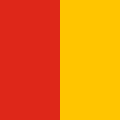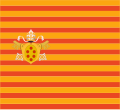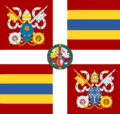| Flag | Date | Use | Description |
|---|
 | | Papal naval ensign | White flag with a version of the coat of arms of the Holy See between the figures of Saint Peter and Saint Paul. |
 | 1300s | Banner of Pope Boniface VIII | A red swallowtail with two golden keys crossed over an umbraculum of the same colour. |
 | 1510s | Banner of Pope Leo X | An orange swallowtail with seven red roundels. |
 | 1520s | | An orange swallowtail featuring two crossed keys on a white shield. |
 | 1520s | Flag used by papal military strategist Jacopo Pesaro | |
 | 1540s | Banner of Pope Paul III | Dark red swallowtail with the keys and tiara design. |
 | 1669–1771 | Flag for Papal Ships | A red flag with Christ on the cross, surrounded by St. Peter and St. Paul. |
 | -1808 [5] [6] | Papal cockade until 1808, de facto state flag [7] | Vertical red and yellow bicolour. |
 | 1808-1870 [8] | Pilot flag, Infantry colours and de-facto civil flag [9] | Vertical yellow and white bicolour. |
 | -1870 | War and proto-national flag [10] flown over Porta Pia during the fall of Rome (1870) [11] [12] [13] | Yellow and white, with simplified coat of arms of the Holy see in the middle |
 | 1803–1825 | Flag for Papal Merchant Ships | A white banner with the keys and tiara in the centre. |
 | 1849 | Flag of the Roman Republic | The Italian tricolour with the phrase DIO E POPOLO
(God and People) in the centre. |
 | 1825–1870 | Flag for Papal Merchant Ships | Vertical yellow and white bicolour with the tiara and keys in the center of the white half. |




































